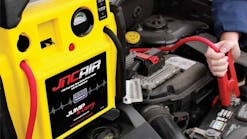How to strategically grow your business with real-time reports
Running any business is an art and a science. There are countless decisions, both daily and long-term, that an owner needs to promote to continue business growth.
In the auto repair industry, shop owners not only need to make sure their team and customers are happy; they also need to ensure that repairs are high-quality and completed efficiently. When everything runs smoothly, the shop is more profitable.
Often, the best insight into the business is a combination of human interaction and hard data. The shop owner that can balance these two elements appropriately is more likely to make stronger business decisions – and over time, increase profitability.
The art and science of running a business
A great business person tends to have a strong intuition and interpersonal relations abilities – both soft skills that can be difficult to finesse over time.
Intuition can steer the split-second decisions a shop owner makes each day, from helping technicians work through challenges to exploring business opportunities, and networking with partners. Interpersonal relations can also allow a business owner to understand the needs of the person they are working with, from employees and business partners to customers and vendors. Honing both skills can become a guiding compass for running a business such as an auto repair shop.
While intuition and interpersonal skills are valuable, they aren’t the only factors that make a business successful. There is also a distinct science to increasing efficiency and profitability, all based on key metrics and data. Data can support a shop owner’s intuition or observations from their interactions with people. It may also reveal key information that can’t be gathered accurately through a conversation, such as profitability, employee efficiency, or parts usage.
The downsides of manually crunching numbers
Data is useful, but manually gathering numbers can be a time-consuming, error-prone process. Without real-time reporting tools, some shop owners may manually calculate the shop’s gross profit for a given month by sifting through every repair order for that month, adding up the total payments, and then subtracting total parts and labor costs.
This process takes hours of extra time that could be better spent supporting the business in other ways, such as interacting with employees or helping with customers. On top of that, it is easy to accidentally leave out a number, resulting in an inaccurate total. Arguably, the only thing worse than making business decisions based on zero data is making business decisions based on the wrong data.
Fortunately, there’s an easier way to get crucial business data: reporting tools inside a repair orders software.
Simplifying data collection and analysis
Repair order software, otherwise known as a shop management system, can make the difference between hours of number-crunching and making quick, well-informed business decisions. At a basic level, a shop management system with real-time reporting tools will store information and automatically crunch the numbers, generating easy-to-use reports.
Knowledge is power – when shop owners analyze detailed, accurate data, they can uncover insights that enable them to make more strategic daily and long-term business decisions, such as:
- Adjusting the shop’s parts matrix and/or labor matrix
- Running deals (or ending them)
- Hiring more technicians and service advisors
- Installing additional bays or opening a new location
Crucial reports from repair orders software
Looking at a shop management system for the first time can be overwhelming. There are numerous reports available, and it takes time to understand which reports are the most beneficial to the shop’s specific needs.
Regardless of report type, a shop management system should offer clear visuals of the data over a time range in an intuitive, customizable format. Shop owners can then understand precisely when data increased or decreased and adjust the shop’s operations as needed.
There are several reports that an owner must consider when using a shop management system. The exact name of the report will depend on which software the shop is using. Generally, the reports fall under four categories:
- Finances: end of day, sales details, and sales tax reports
- Employee activity: technician efficiency and service writer sales reports
- Customer activity: job history, declined jobs, and lead sources reports
- Parts activity: parts ordered and parts usage reports (for parts reconciliation purposes)
Financial reports
Financial reports provide details on the shop’s overall performance, such as day-to-day operations or profitability over a specific time range. Understanding the shop’s finances, where it has earned and lost profit and what caused any changes, enables shop owners to make stronger, more responsible financial decisions. These reports may also reveal the true nature of the shop’s financial standing – whether better or worse than what the shop owner might expect.
Employee activity reports
Knowing how the team is performing is key to maintaining a smooth-running business where employees can thrive. Employee efficiency, particularly when compared to the shop’s car count, is a crucial metric for determining whether it’s time to hire additional team members or make additional adjustments.
Employee activity reports offer a comprehensive, data-based overview of employee performance. They can also enhance employee management and training by offering key data the employees themselves may not even know. This includes numbers and percentages related to productivity, service advisor close-ratio, or the monetary value of a repair order. With this information, a shop owner can identify top performers and work with other team members at different levels to increase their skillsets and productivity.
Customer activity reports
Understanding the customer allows a shop owner to ensure the shop is offering services that the customers need and want. Customer activity reports provide important information on the shop’s specific target audience – the people that keep the shop open.
Some customer activity reports may focus on marketing, which reveals how customers hear about the shop or which outreach methods are most effective. Others may tell the shop owner about declined jobs, so they can encourage service advisors to follow up with customers later.
Parts activity
Parts ordering and parts usage play an enormous role in a shop’s overall profitability. By reviewing parts activity reports, shop owners can understand whether they are buying more parts than needed, or if the pricing in their parts matrix is correct. When used appropriately, parts activity reports can help identify any discrepancies that may show up in both the accounting and repair processes.
Make decisions backed by data
When a shop owner makes business decisions based on real-time data, they can have peace of mind that the numbers are supporting their decision – whether hiring additional technicians or expanding to a second location. Sometimes the data will reveal unpleasant information, but this is equally important in enabling a shop owner to adjust before the situation gets worse.
When shop owners use data, intuition, and interpersonal relations in harmony, they will inevitably end up with a winning formula for success that lifts everyone – from the owner to the customer – and leads to greater profitability for the business.
Information provided by Tekmetric



